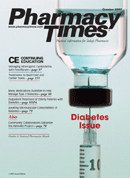Publication
Article
Pharmacy Times
DIPS: A Tool to Evaluate Causation in Potential Drug Interactions
Determining the relationship of an adverse event to the administration of one or more drugs is an essential but often difficult task. When a patient develops an adverse event, it may be related to a known or unknown disease or caused by one or more drugs in the patient's regimen. If a drug-induced cause of the event is suspected, it may be the result of a drug-drug interaction. It is important to determine if a drug interaction is involved; establishing causation can lead to identification of new drug interactions, whereas ruling out an interaction can narrow the list of potential causes and help to focus on an appropriate response.1
Since the 1980s, a scale commonly referred to as the Naranjo Nomogram has been used to estimate the probability that an adverse event was drug-induced. 2 Although this tool has been applied successfully to evaluate drug-induced adverse events, it was never designed to assess the potential for 2 interacting drugs to cause an adverse outcome.
Using the format introduced by Naranjo, we have developed a tool to evaluate the causation of an adverse event thought to be produced by the interaction between 2 drugs.3,4 The Drug Interaction Probability Scale (DIPS) uses a series of 10 questions to assess the probability that a causal relationship exists between an event observed in a patient and the administration of 2 drugs. Each question is answered with a "yes," "no," or "unknown/not applicable" response. For each question, a numeric score is assigned to the answer, and the scores from all 10 questions are tallied. The total score is used to estimate the probability that the interaction is causally related to the patient event. Probability is assigned as doubtful, possible, probable, or highly probable.
The questions focus on the known properties of the 2 drugs being evaluated for the potential interaction. For example, if the object drug is primarily eliminated from the body by metabolism via the enzyme CYP2D6, is the suspected precipitant drug known to inhibit CYP2D6? If it is not, an alternative mechanism for the interaction between the 2 drugs needs to be identified, or another cause for the object drug-induced adverse event needs to be considered.
Assessment of the timing of the observed events in relationship to drug administration, the presence of objective evidence (eg, changes in plasma concentration of the object drug) of the interaction, and the results of drug dechallenge or rechallenge are included in the DIPS causation analysis.
Evaluation of other potential causes for the observed event is an important consideration when trying to determine causation, however. For example, a drug interaction may be suspected when an alternative explanation such as a drug-disease interaction or patient nonadherence to the dosage regimen is present. Evaluation of alternative causes requires extensive knowledge of both the patient and the properties of the 2 drugs in question.
As knowledge of the mechanisms of drug-drug interactions has evolved, experts have become more accurate in predicting drug combinations that might interact and produce an observable outcome in patients. Since not all, or even a majority, of patients receiving a pair of interacting drugs will experience an adverse event, it is important to carefully evaluate those patients who experience clinically significant outcomes thought to be caused by a drug interaction. Only by consistently evaluating the clinical outcome of potential drug interactions can appropriate decisions be made regarding patient management.
Drs. Horn and Hansten are both professors of pharmacy at the University of Washington School of Pharmacy. For an electronic version of this article, including references if any, visit www.hanstenandhorn.com.
References
1. Horn JR, Hansten PD. How to assess drug interaction case reports. Pharm Times. August 2006;72:32.
2. Naranjo CA, Busto U, Sellers EM, et al. A method for estimating the probability of adverse drug reactions. Clin Pharmacol Ther. 1981;30:239-245.
3. Hansten PD, Horn JR. The Top 100 Drug Interactions: A Guide to Patient Management. 2006 ed. Freeland, WA: H&H Publications; 2007:235-236.
4. Horn JR, Hansten PD, Chan LN. Proposal for a new tool to evaluate drug interaction cases. Ann Pharmacother. 2007;41:674-680.







